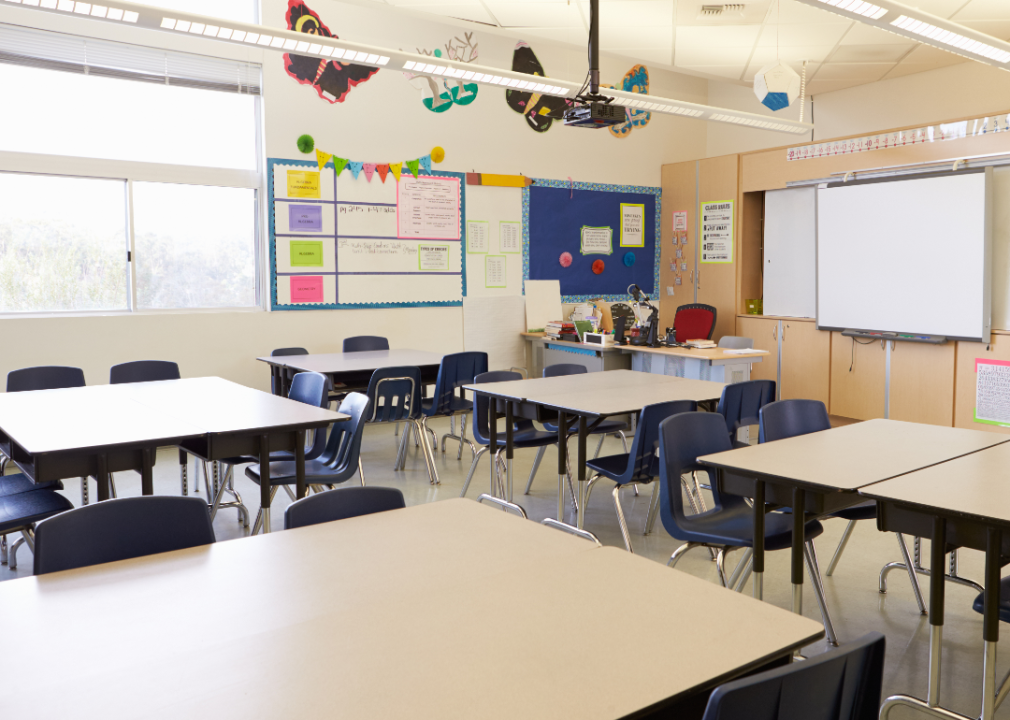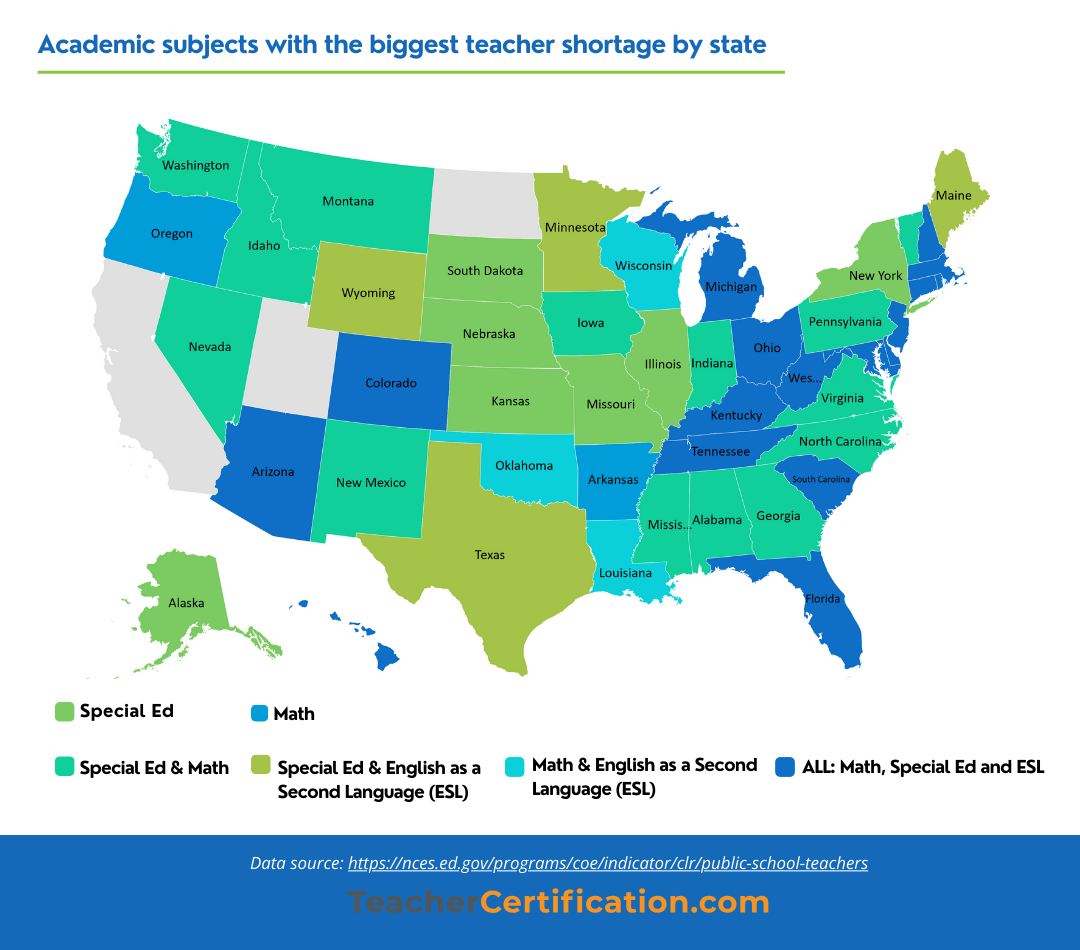Which states need K-12 educators the most—and in which subjects?

Canva
Which states need K-12 educators the most—and in which subjects?
empty classroom
The declining retention of teachers is a critical issue impacting the quality and accessibility of education for students nationwide. Between February 2020 and May 2022, around 300,000 public school teachers and employees left the education field, according to ABC News, which refers to data from the U.S. Bureau of Labor Statistics. CNN reports that most of these educators weren’t retired or otherwise let go from their jobs – they quit.
The outlook remains challenging, with one in three K-12 teachers seriously considering leaving the teaching profession in the next two years. In fact, so many teachers have quit since February 2020 that these resignations are driving the current teacher shortage in the U.S.
TeacherCertification.com looked at teacher shortage data from the U.S. Department of Education to understand the impacts of teacher shortages throughout the U.S. This article focuses on the three subjects with the greatest demand: English as a Second Language, Mathematics, and Special Education.
Complementary data comes from EdWorkingPaper, Brookings, Teachershortages.com, the U.S. Department of Education, EdWeek, NewAmerica, CNN, the U.S. Bureau of Labor Statistics, and The Nation’s Report Card.
![]()

Alina Lehtinen-Vela // TeacherCertification.com
Teacher shortages
color map of US showing each state’s biggest subject-based teacher shortage
Currently, there are at least 36,000 vacant positions along with at least 163,000 positions being held by underqualified teachers, both of which are conservative estimates of the extent of teacher shortages nationally. Additionally, the overall employment of special education teachers is projected to show little or no change from 2022 to 2032.
However you look at it, most states are experiencing some kind of teacher shortage.
According to data from the U.S. Department of Education, the most in-demand teachers are those in Mathematics, English as a Second Language, and Special Education.
State-specific shortages
California, Utah, and North Dakota are the only states without a teacher shortage in Math, ESL, or Special Education. While every other state is experiencing a teacher shortage in at least one of the three most in-demand subjects, 18 states are experiencing shortages in all three.
Arizona, Colorado, Connecticut, Delaware, the District of Columbia, Florida, Hawaii, Kentucky, Maryland, Massachusetts, Michigan, New Hampshire, New Jersey, Ohio, Rhode Island, South Carolina, Tennessee, and West Virginia are all experiencing teacher shortages in Math, ESL, and Special Education.
Demand for English as a Second Language (ESL) teachers
25 out of 50 states are currently experiencing a shortage of ESL educators.
ESL consists a methodology involving special techniques and curriculum designed to teach English Language Learner, or ELL, students English language skills, including listening, speaking, reading, writing, vocabulary development, study skills, and cultural orientation.
According to NewAmerica, there has been a nearly 10% decline in the number of educators for English language learners, even as the ELL student population is growing. Additionally, average composite English language proficiency scores “trended lower in the 2021-22 school year than pre-pandemic 2018-19 and 2019-20 years,” as reported an April 2023 EdWeek story.
In February 2023, the White House released its proposed budget for the 2024 fiscal year, allocating $1.2 billion towards enhancing the education of English learners and multilingual learners, as part of Title III funding.
Several states are also addressing this need through various means. Texas and Rhode Island are two examples of states that have introduced legislation to address their workforce needs.
In Texas, HB 2168 proposes the development of a specialized program by the state education agency that aims to prepare students who are interested in pursuing a career in teaching English learners.
In Rhode Island, H 6023 introduced the “Multilingual Educators Investment Act,” which plans to boost the number of teachers skilled in bilingual and world languages in schools. It also establishes a scholarship program to increase the number of multilingual teachers in the urban core and urban ring public schools.
Demand for Math teachers
There is a shortage of Math educators in 38 out of 50 states.
As explained by the International Commission on Mathematical Instruction, “Mathematics is a fundamental part of human thought and logic, and integral to attempts at understanding the world and ourselves. Mathematics provides an effective way of building mental discipline and encourages logical reasoning and mental rigor.”
The Nation’s Report Card reported that math scores for the 2022-23 school year among 13-year-old students have declined compared to the results from most previous assessments done in the 2019-20 school year. Out of a possible 500 points, 2022-23 participants scored an average of 271, 9 points lower than the average score of 280 in 2019-20.
The differences between this year’s score and the score from a decade ago are even more dramatic. The average scores in math have declined by 14 points when compared to the results from 2012-13.
U.S. Education Secretary Miguel Cardona said, “Schools have committed nearly 60 percent of their American Rescue Plan to address lost learning time and accelerate academic recovery by hiring more teachers, counselors, and support staff, providing more tutoring and one-on-one support to students, and extending learning time through high quality afterschool and summer learning programs.”
Special Education teachers
The shortage of Special Education (SE) educators is the greatest, with a documented shortage in 44 of 50 states.
Edweek defines special education as “the programs which serve students with mental, physical, emotional, and behavioral disabilities.” Furthermore, the Individuals with Disabilities Education Act (IDEA) guarantees a “free appropriate public education” to the “maximum extent appropriate” for children with disabilities in the “least restrictive environment” alongside their nondisabled peers.
The Brookings Institution studied a Texas policy that imposed a cap on district-level special education enrollment to determine the effectiveness of special education. The policy specified that to meet state standards, districts needed to maintain their SE enrollment at or below 8.5%. This led to a decline in SE enrollments from approximately 12% to 8.5% over a decade.
While it was later found that this cap was against the federal disability law, Brookings states that this provided a “unique opportunity to learn about who benefits from SE services.” The study also found that diminished access to special education led to notable decreases in the academic achievements of students who were formerly categorized as special education learners. These students were less likely to complete high school and/or enroll in college.
A separate Brookings article found that qualified special education educators have been a challenge for schools since at least 1975, the year the IDEA Act was signed into law. These positions stay open longer and have fewer applicants.
This story was produced by Teachercertification.com and reviewed and distributed by Stacker Media.